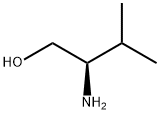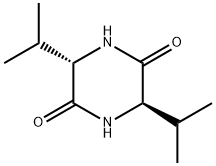| Identification | More | [Name]
(R)-(-)-2-Amino-3-methyl-1-butanol | [CAS]
4276-09-9 | [Synonyms]
2-AMINO-3-METHYLBUTAN-1-OL
D-2-AMINO-3-METHYL-1-BUTANOL
D-VALINAL
(-)-D-VALINOL
D-(-)-VALINOL
D-VALINOL
(D)-VALINOL/(R)-(-)-2-AMINO-3-METHYL-1-BUTANOL
H-D-VAL-OL
(R)-(-)-2-AMINO-3-METHYL-1-BUTANOL
(R)-(+)-2-AMINO-3-METHYL-1-BUTANOL
(R)-2-AMINO-3-METHYL-1-BUTANOL
(R)-(-)-2-AMINO-3-METHYLBUTAN-1-OL
(R)-(-)-2-AMINO-3-METHYLBUTANOL
R-VALINOL
D-(-)-VALINOL 98%
(R)-(-)-Z-Amino-3-Methyl-1-Butanol
D-Val-ol
D-(-)-Valinol,98%
1-Butanol, 2-amino-3-methyl-, (2R)-
(R)-(-)-2-Amino-3-methyl-1-butanol | [EINECS(EC#)]
217-975-5 | [Molecular Formula]
C5H13NO | [MDL Number]
MFCD00064297 | [Molecular Weight]
103.16 | [MOL File]
4276-09-9.mol |
| Chemical Properties | Back Directory | [Appearance]
white to light yellow crystal powde | [Melting point ]
35-36 °C(lit.) | [alpha ]
-16.5 º (c=10, EtOH) | [Boiling point ]
189-190 °C(lit.) | [density ]
0.931 g/mL at 20 °C(lit.)
| [refractive index ]
n20/D 1.455
| [Fp ]
194 °F
| [storage temp. ]
2-8°C
| [solubility ]
DMSO (Slightly), Methanol (Slightly) | [form ]
Low Melting Crystals or Crystalline Mass | [pka]
12.82±0.10(Predicted) | [color ]
White to light yellow | [Optical Rotation]
[α]20/D 16°, c = 10 in ethanol | [Sensitive ]
Air Sensitive | [BRN ]
1719138 | [InChIKey]
NWYYWIJOWOLJNR-YFKPBYRVSA-N | [CAS DataBase Reference]
4276-09-9(CAS DataBase Reference) | [Storage Precautions]
Air sensitive;Store under nitrogen |
| Safety Data | Back Directory | [Hazard Codes ]
Xi | [Risk Statements ]
R36/37/38:Irritating to eyes, respiratory system and skin . | [Safety Statements ]
S26:In case of contact with eyes, rinse immediately with plenty of water and seek medical advice .
S36/37:Wear suitable protective clothing and gloves .
S36:Wear suitable protective clothing . | [WGK Germany ]
3
| [F ]
10-34 | [HS Code ]
29221990 |
| Hazard Information | Back Directory | [Chemical Properties]
white to light yellow crystal powde | [Uses]
D-Valinol is used as a reagent in the synthesis of the HIV type 1 integrase inhibitor Elvitegravir (E509000). D-Valinol is also used in the preparation of novel 2-(alkylmorpholin-4-yl)-6-(3-fluoropyridin-4-yl)-pyrimidin-4(3H)-ones as orally active GSK-3β inhibitors for Alzheimer''s disease. | [Synthesis]
General procedure for the synthesis of D-valinol and compounds (CAS:19943-14-7) from D-valine methyl ester hydrochloride: Hydrogenation of R-phenylglycine methyl ester was carried out in a 0.5 L stainless steel electrolyzer with stirring at 500 rpm to test the catalyst activity. First, 1 g of catalyst (20-40 mesh) was loaded into the reactor and subsequently purged five times with H2 to remove air. The catalyst was reduced at 1 MPa H2 pressure and 250 °C for 4 hours. After the autoclave was cooled to room temperature in H2 atmosphere, 1.5 g of R-phenylglycine methyl ester (R-p-m) diluted by 150 mL of ethanol (R-p-m/Cat = 1.5, w/w) was added. The reaction conditions were set at 5 MPa H2 pressure and 80 °C temperature for 10 hours. Upon completion of the reaction, the autoclave was cooled to room temperature in H2 atmosphere, followed by separation of the solid catalyst by centrifugation. The product was purified by silica gel column chromatography using ethyl acetate/methanol (3/2, v/v) as eluent. Finally, the light yellow powdery product was obtained by rotary evaporation. The analysis of the reactants and products was carried out using a high performance liquid chromatograph (HPLC, Agilent 1260 Infinity) equipped with a UV detector and an Eclipse XDB-C18 column (150 × 4.6 mm, 5 μm particles), which in turn was used to calculate the conversion of R-phenylglycine methyl ester (X), yield (Y), and chemoselectivity for R-phenylglycine (S), where yield is the liquid chromatographic yield. The enantiomeric excess values (ee values) of the products were determined by HPLC equipped with a UV detector (wavelength 258 nm) and a chiral column (CHIRALPAK AY-H, 250 × 4.6 mm, 5 μm particle size). | [References]
[1] Catalysis Letters, 2017, vol. 147, # 8, p. 2160 - 2166 |
|
|







